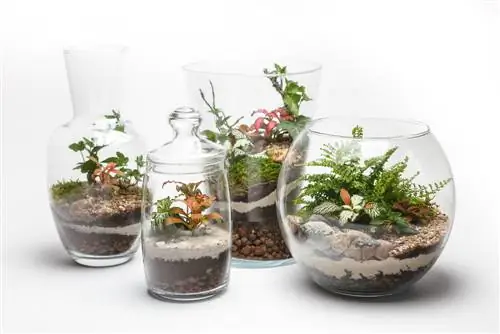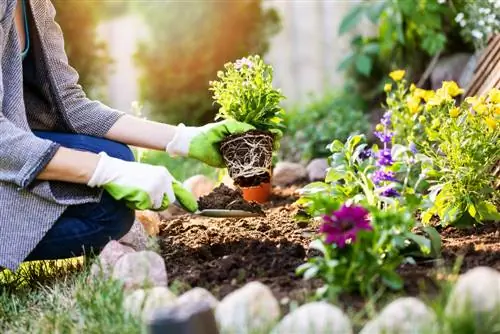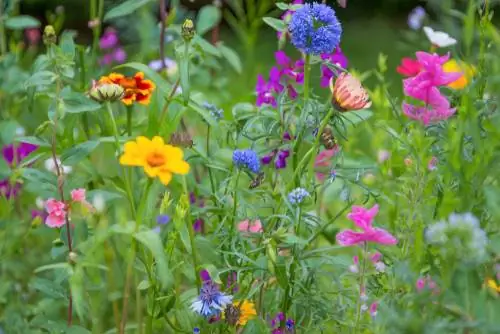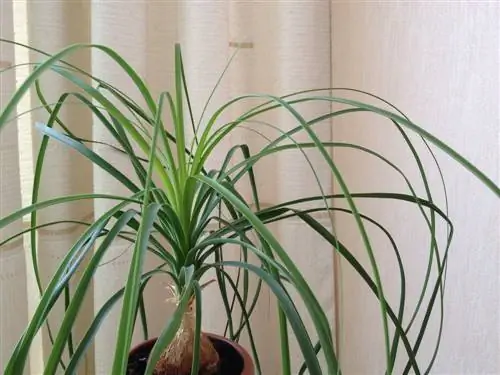- Author admin [email protected].
- Public 2023-12-26 14:17.
- Last modified 2025-06-01 06:02.
In the bottle garden, a mini biotope thrives under ideal conditions. The easy-care solution for indoor gardeners with a penchant for trendy plant ideas. How to properly create a lush garden in a glass container.

- Bottle garden is a mini biotope in a glass vessel, consisting of the components plants, light, air, water, microorganisms, animals and granules.
- Indoor gardeners can buy a ready-made bottle garden or use the ingredients to make a lush mini biotope in a glass themselves.
- Suitable plants for the bottle garden are bromeliads, ferns, mosses, mini orchids, small-leaved ivy, bonsai, carnivores and cacti.
What is a bottle garden? - How it works simply explained
Bottle garden is a plant composition in a glass as an autonomous ecosystem in mini format. Ideally, a bottle garden is created once, sealed airtight and takes care of itself in the future without the indoor gardener having to lift a finger. Ingredients for the glass mini biotope are:
- Glass vessel: simulates the atmosphere that envelops our planet
- Plants: provide oxygen, carbon dioxide and build nutrients
- Light source: either natural sunlight or plant lamp for photosynthesis and oxygen production
- Air: transports oxygen and carbon dioxide for cellular respiration of plants and animals
- Water: important for photosynthesis and to protect against drought stress in the ecosystem
- Microorganisms: Bacteria and protozoa process dead plant parts into nutrients
- Animals: produce carbon dioxide and break down dead plant material for microorganisms
- Granulate: serves as a planting base and drainage to prevent waterlogging
The way the bottle garden works reflects the natural cycle of nature. Plants absorb water through their roots and sweat it out through their leaves. The moisture settles on the glass wall as condensation, evaporates or runs into the substrate and is available to the plants again. Incoming light drives photosynthesis. Carbon dioxide is converted into oxygen and light energy into nutrients.
Excursus
Hermetosphere in the bottle garden for eternity
In what is probably the oldest bottle garden in the world, the lid was only opened once in 58 years, the plants were watered and the container was sealed airtight again. Nevertheless, a lush miniature garden thrives inside because hermetosphere reigns here. This technical term is made up of “hermetice” (closed) and “sphaira” (envelope). In the airtight bottle garden there is a self-contained ecosystem with a perpetual cycle of green life that is not dependent on any outside supply.
Buy ingredients for the bottle garden
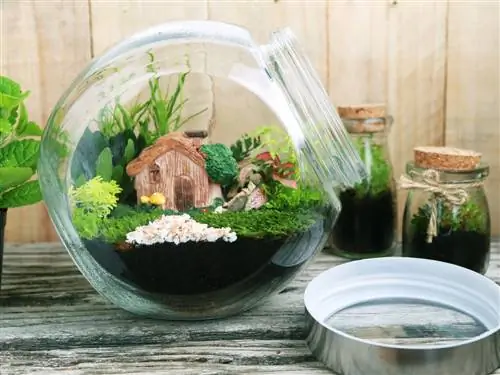
Various containers are suitable for the bottle garden
Bottle gardens have been around for more than 100 years. However, the ingenious biosphere in glass has so far had a niche existence. You can only buy a finished bottle garden from local specialist retailers because it is not possible to ship it intact. For the ambitious indoor gardener, it is a matter of honor to make the mini garden in a bottle yourself. The following table provides an overview of the suitable ingredients for the DIY bottle garden:
| glass container | Substrate | Plants | Microorganisms/Animals | Accessories/Tools |
|---|---|---|---|---|
| Bottle | lava granules | Bromeliads | Springtails | Funnel |
| Mason jar | expanded clay | Ferns | White woodlice | Tweezers |
| bonboniere | Seramis | Moose | Centipede | Ball shower |
| Wine balloon | Pumicestone | Mini orchids | Bacteria | Rainwater/mineral water |
| Carafe | Akadama | small-leaf ivy | Single-celled organisms | Brush, kitchen sieve, cloth |
| Aquarium | peat moss | Bonsai | Charcoal/Activated Carbon | |
| Glass ball | Coconut soil | Carnivores | Decorative material |
As this overview demonstrates, there are no limits to your imagination when it comes to choosing a vessel. There is less scope for your own ideas regarding plant composition and substrate. The following sections provide additional information on the right components for the perfect bottle garden.
Glass Containers - Inspirations
The purely technical requirements for the suitable vessel are quickly de alt with. It should be transparent and ideally sealable airtight. When it comes to selection, this means: Whatever you like is allowed as long as these two fundamental criteria are met. A simple glass vessel puts the plants in the spotlight. The playful design of a glass biosphere tends to distract from the green beauties in the bottle garden.
A wide-necked carafe makes planting and design work much easier. Indoor gardeners with sensitivity opt for the rustic milk bottle or the elegant wine balloon with a narrow neck. Acrylic glass balls, which seem to float weightlessly with their green load on the ceiling, are very popular for the trendy bottle garden at eye level. If cacti take center stage in the bottle garden, the time has come for the old mason jar whose lid has been lost.
Substrate - tips for the right granules

The soil for the bottle garden should be chosen carefully
So that the natural cycle of substances in the ecosystem functions smoothly, organic elements in the bottle garden should be reduced to a minimum. For this reason, conventional potting soil or compost soil is taboo as a substrate. Choose inorganic or almost germ-free substrate qualities in which the plants like to stretch out their roots and are not bothered by mold or similar calamities. The table above names suitable planting substrates that meet the following criteria for a bottle garden in top form:
- Structurally stable granules with a grain size of 2 to 6 mm
- Chemically neutral, neither calcareous (alkaline) nor acidic (pH value less than 5)
- Lean, without high nutrient content to reduce growth in confined spaces
Against this background, the use of lava granules has proven itself excellently for many years. If a thin layer of substrate is advantageous for cultivating moss, ferns or carnivores, we recommend unfertilized coconut soil.
Plants - ideas for choosing

Various plants can be used for planting the mini garden
As the main characters in the bottle garden, plants have a special meaning. Give preference to tropical, small-growing, small-leaved species that feel right at home in the warm, humid microclimate. Cacti, thick leaves, houseleeks and other succulents are not suitable for an airtight glass container with a hermetosphere and will die within a short time. The following species and varieties have proven themselves excellent in practice for life in the eternal biotope:
- Bromeliads: preferably small terrestrial bromeliads of the genus Earth Star (Cryptanthus)
- Ferns: Maidenhair Fern (Adiantum), Dwarf Clover Fern (Marsilea hirsuta), Spotted Fern (Polypodium)
- Moss: Star moss (Hyophila involuta), Pelliam moss (Monosolenium tenerum), Peat moss (Sphagnum)
- Mini Orchids: Butterfly Orchid (Phalaenopsis), Boat Orchid (Cymbidium), Grape Orchid (Dendrobium)
- Ivy: small-leaved ivy (Hedera helix), e.g. B. the variety Green Pittsburgh
- Bonsai: ideally Chinese fig (Ficus Ginseng) or Ficus microcarpa
- Carnivores: Pitcher Plant (Nepenthes), Venus Flytrap (Dionaea), Sundew (Drosera)
You can conjure up a successful plant community in the large, bulbous bottle garden with Java fern (Microsorum pteropus), Congo water fern (Bolbitis heudelottii), moss fern (Selaginella), mini South Sea palm (Biophytum sensitivum), African violet (Saintpaulia ionantha), Cuban pearlwort (Hemianthus callitrichoides), dwarf pepper (Peperomia), tender liverwort (Monosolenium tenerum) as well as the carnivorous Cape sundew (Drosera capensis) and bladderwort (Utricularia sandersonii).
Microorganisms/animals for recycling
If certain animals frolic in the glass ecosystem, waste recycling is well taken care of. Springtails (Collembola) and white woodlice (Trichorhina tomentosa) diligently chop up dead plant parts for microorganisms such as bacteria and protozoa. The latter decompose the organic matter and produce life-giving nutrients for he althy plant growth. Microorganisms find their way into the bottle garden without your intervention. The small animals are available in pet stores.
Accessories and tools
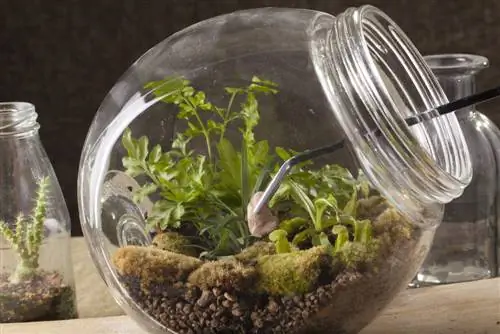
Tweezers help to “plant” the bottle garden
Useful accessories and practical tools set the stage for a premium quality bottle garden. A funnel provides valuable assistance when pouring granules into a narrow-necked bottle. This could be a cardboard roll of kitchen paper or the cut neck of a PET bottle. Long kitchen tweezers should always be at hand to insert delicate plants into the mini biotope or to pluck out dead plant parts later.
If a plant garden is watered with a ball shower, you can dose the water precisely. This aspect is invaluable in preventing waterlogging. Furthermore, a dirty glass wall can be easily cleaned with this tool. Pamper tropical plants with soft rainwater right from the start. If you don't have the opportunity to collect the rain yourself, water with still mineral water. Charcoal as an additive in the granulate prevents the dreaded mold formation in the eternal bottle garden.
Aparte decorative material gives your creative bottle garden the finishing touch. The spectrum extends from well-formed natural stones to bizarre branches and pretty minifigures.
The following video presents a colorful array of decorative design ideas for a bottle garden with a WOW effect:

Creating a bottle garden - DIY instructions
Never has the right approach been more important than when starting your bottle garden project. While with conventional houseplants you can always take corrective action afterwards, an autonomous ecosystem develops best without external disturbances. The following DIY instructions explain step by step how to make the perfect bottle garden yourself:
Preparatory work
Cleanliness is king when you make a bottle garden yourself as a self-sufficient ecosystem. Please pay special attention to the following preparatory work:
- Put all ingredients on the table within easy reach
- Clean the glass container carefully with soap, hot water and a brush and rub dry
- Rinse the granules in the kitchen sieve under running water and allow to drain
- Clean decorative material and let it dry
Create drainage
Regardless of their preference for humid conditions, tropical plants have an aversion to constantly wet feet. By creating your bottle garden with drainage as the bottom layer, you can effectively prevent waterlogging. If you have chosen lava granules or expanded clay as a substrate, the suitable material is already on the table. Alternatively, small, clean pebbles ensure that the roots do not stand in water. How to do it right:
- Place funnel on glass container
- Fill drainage material to cover the ground
Fill substrate with charcoal
In a normally shaped vessel, a layer height of 10% to 20% of the total height has proven to be good for the substrate. This results in a 3 to 6 cm high filling for a 30 cm high glass vessel as a planting base. To ensure that the subsequent planting is as gentle as possible on the roots, please fill in the substrate in stages. How to do it professionally:
- Mix substrate with charcoal
- Pour 2/3 of the amount into the container
Alternatively, fill in the entire amount of substrate and drill suitable troughs for the plants.
Planting plants
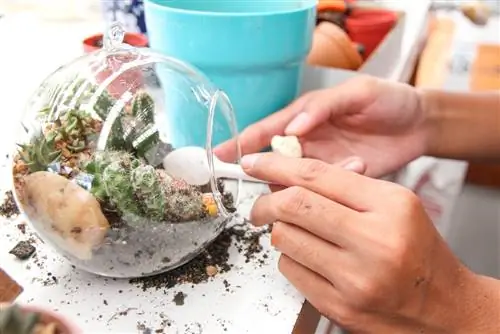
The larger the container opening, the easier it is to create the bottle garden
So that no potting soil gets into the bottle garden, first subject the plants to pre-treatment. The actual planting process requires sensitivity. This is how it works:
- Pull plant shoots apart one at a time with your fingers
- Shake off the earth
- Dip the shoots with the roots into low-lime water
- Place plant shoots in the glass jar using the tweezers
- fill in remaining granules until the roots are covered
It is important to note that you use submerged plant shoots immediately. Even just a few minutes of exposure to air causes the valuable shoots to wilt.
Place decorations
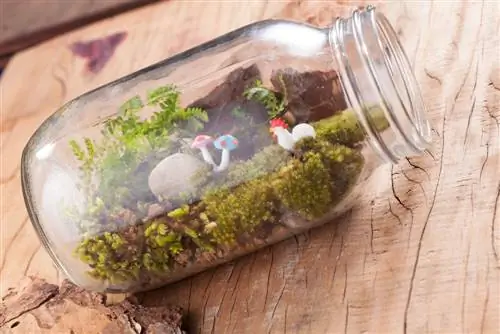
A beautiful decoration is the be-all and end-all of a bottle garden
After planting, you can model the substrate surface with peat moss, colorful pebbles and other decorations.
Settle animals
Now it's time to settle the animal residents in the bottle garden. Please place springtails, woodlice or centipedes in the glass container according to the breeder's instructions.
Water the bottle garden
The plants are now carefully watered with soft water from the ball shower. Please adjust the amount of water used to the moisture of the substrate. Granules that have been rinsed beforehand are usually already sufficiently moist or require very little watering. How to do it right:
Rule of thumb: The correct amount of water in the bottle garden is reached when the granules are wet but no water is visible on the bottom of the glass
Seal the container airtight
Finally, close the bottle garden with a lid.
Tip
Cacti have nothing against living in a bottle garden. However, the glass container should remain open. Too high humidity is poison for every cactus in the glass. Because a self-sufficient ecosystem cannot form without a cover, the succulents are watered every now and then.
Bottle garden - care tips
For good reason, bottle gardens make the hearts of enthusiastic indoor gardeners beat faster because the maintenance effort is kept to a minimum. The green mini paradise in the glass is particularly easy to care for if it is sealed airtight. But cacti in open containers are also forgiving of many a beginner's mistake. There are only the following care tips to follow:
- Location: shaded to partially shaded without direct sunlight so that the leaves do not burn
- Rotating: Rotate glass containers regularly for even plant growth
- Cleaning out: every now and then pluck off the dead plant parts with tweezers
- Open: water drops constantly run down the glass wall, open the bottle garden so that the excess water evaporates
A properly designed bottle garden with a functioning ecosystem does not need to be fertilized. On the contrary, a supplementary supply of nutrients causes undesirable growth in a limited space.
Frequently asked questions
Which plants are suitable for a bottle garden?
Small plants of tropical origin are best suited for the bottle garden. A convincing example are the exotic three-master flowers (Tradescantia), which have been thriving magnificently in David Latimer's famous wine balloon for almost 60 years. In this sense, bromeliads, ferns, mini orchids, carnivorous plants, star moss or peat moss are suitable for plant selection. Tropical swamp and aquatic plants, such as water goblet (Cryptocoryne), are also recommended.
The glass wall in the bottle garden always fogs up. What to do?

If the glass container fogs up, it is too humid in the bottle garden
If the glass wall is constantly fogged up, the bottle garden is too humid. If the humidity is too high, mold formation and plant diseases are inevitable. Open the container for a while to allow the excess condensation to evaporate. From now on, the plants should be watered less frequently.
Do plants in the bottle garden need to be fertilized?
No, supplementary nutrient supply is not necessary in the bottle garden. The water that has been filled once evaporates in the airtight glass container, whereupon the glass wall briefly fogs up. Under the influence of sunlight, nutrients develop in the ecosystem as a motor of growth, while photosynthesis produces the vital oxygen. If an open bottle garden is home to frugal cacti, fertilizer is also not used.
Moss and leaves in the bottle garden turn yellow. Why is that?
If plant parts turn yellow, the bottle garden is too bright. Direct sunlight causes moss and leaves in the glass container to burn. A change of location solves the problem. The best place for a bottle garden is on a partially shaded windowsill, preferably facing north, north-west or north-east.
Why do native plants always die in an airtight bottle garden?
There is a hermetosphere in the airtight glass container, which represents an extreme habitat for plants. Almost 100 percent humidity, no gas exchange, hardly any nutrients and high temperatures in summer significantly restrict metabolism. Plants that are naturally native to warm, humid, tropical climates are primarily equipped to meet these requirements. Native species have no resistance to this challenge.
How do I get rid of excess water in the bottle garden?
Don't pay attention once and the plants are waterlogged because too much was watered. This is no reason to clear out the bottle garden and drain it. Leave the container uncovered for a few days so that the water evaporates.
Which light sources are suitable for a bottle garden that is not on the windowsill?
White light is the best option if artificial lighting is to serve as a full replacement for daylight. This contains all light colors that can be used for plant physiology. Unusable light is reflected so that the plants in the glass retain their natural appearance. A disadvantage is that the bottle garden fogs up all around when it is far away from a window because the container becomes warm on all sides. On the window sill, only the cooler, outward-facing glass wall fogs up and provides a clear view of the green interior on the opposite side.
How do I clean a dirty glass wall in an airtight bottle garden?
It is not necessary to open an airtight bottle garden for cleaning work. You can clean a glass wall from the outside with a magnetic cleaner. The practical aid is known from aquarium care and consists of two magnets covered with felt. You can buy magnetic cleaners from aquarium stores or make them yourself. You can do this with flipchart magnets from office supplies, which you cover with a thin layer of felt.
I would like to illuminate a preserving jar in color as a bottle garden. In which light color do photosynthesis and growth work best?
Photosynthesis in the colored illuminated bottle garden works best under a red and blue light source. Plants absorb light using leafy greens known as chlorophyll. This dye can absorb and process blue and red light, but not green light.
Tip
Indoor gardeners in urban environments often have no way of collecting rainwater for the bottle garden. A gardening trick turns normal tap water into low-lime irrigation water for your tropical plants in a glass container. Simply fill 1 liter of peat into a cotton bag and hang it in a 5 liter watering can for 24-48 hours. The result is soft irrigation water in rainwater quality.

